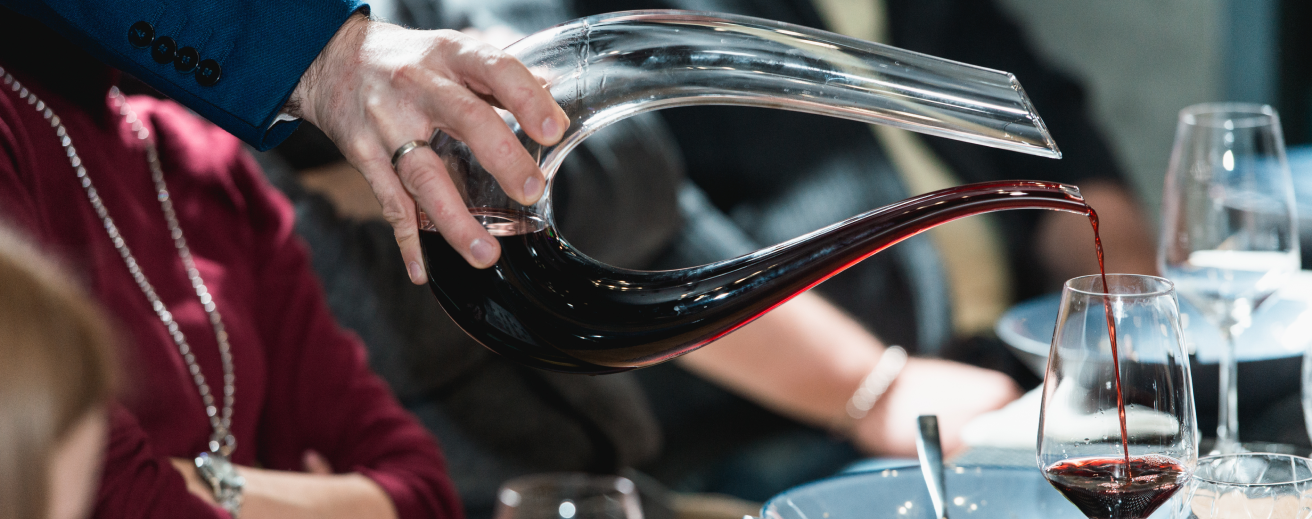
What is a Decanter?
Has anyone ever told you to let your wine “breathe” before sipping? This usually involves letting the freshly uncorked bottle sit for a while, swishing the wine in the glass, or using a wine decanter.
Decanting wine can take a few different forms, and the type of decanter will vary depending on your needs.
To get the most out of your wine tasting, let’s take a closer look at the art of decanting.

What is a Decanter Used For?
If you’ve seen someone pour a bottle of wine into a clear container with a long neck and broad base, you’ve seen a wine decanter.
Two common reasons for decanting include aerating the wine, exposing it to oxygen to enhance the flavors and aromas, and searching for sediment, which is common in red wine that has been aged.
A decanter is ideal for full-bodied red wines less than two years old and high in tannins, as the oxygen will smooth out these more potent textures.
For a vintage sipper, holding the decanter at an angle as you pour the wine will allow you to see clouds of sediment, the dead grape yeast (also known as lees). Once the sediment falls to the bottom of the decanter, you’re ready to pour the wine into a glass and serve.
Decanters are also used for aerating other alcoholic beverages like whiskey and cognac.
Now that we know what a decanter is, how do we choose the best one?
Choosing a Decanter
Selecting the perfect decanter for at-home wine tasting depends on the wine you’ll be sipping. Visual appeal is also a factor, as some decanters are simply pretty to look at.
For example, the “swan” decanter bears a long slanted neck and shorter side resembling a swan tail.
As long as the decanter provides enough surface area for your wine to aerate, you’re good to go!
Here are a few other types of decanters to consider.
Types of Decanters
Each decanter size fits a specific type of wine. You can also choose between glass and crystal decanters.
Glass Decanter vs. Crystal Decanter
The main difference between glass and crystal decanters include shape and durability.
Since crystal is much more durable than glass, these decanters feel thinner and can be morphed into “fancier” shapes, like with the swan decanter.
Since glass is more fragile, these decanters are often thicker and are made into much simpler, compact shapes.
A common concern with crystal is that it is lead-based. However, the chances of lead seeping into your wine are incredibly low as you should only let your wine aerate for a short period of time for the best balance of flavors and aromas.
If you are still concerned about lead, you can opt for a lead-free glass decanter.
Small and Medium Decanters
Decanters on the petite side are best for aerating white wines, Rosé wines, and lighter-bodied reds like Pinot Noir. This allows oxygen just enough surface area to open up those delicate fruity and floral notes without washing them away.
Medium decanters work best for medium-bodied red wines like Merlot and Grenache, as they provide just enough aeration to bring out the wines’ subtle red fruit aromas.
A good rule to remember is light decanters with light wines, medium decanters for medium wines, and larger decanters for heavier, robust red wines.

Wide Base Decanters
Since wide base decanters allow even more oxygen to permeate the surface area, robust red wines like Syrah and Cabernet Sauvignon are well suited for this type as their complex structure and flavor profile can handle it. The astringent mouthfeel created by a tannic wine like Sangiovese, for example, will become more mellow and velvety after a short time in the decanter, improving the wine's jammy, fruit-forward flavors while balancing texture and flavor in perfect harmony.

What About Decanters for Sparkling Wine?
Sparkling wines like Champagne and Prosecco are airy and delicate with a soft and sweet, aromatic essence. It’s best to serve your sparkling wine immediately after a short time in the fridge to get the most out of its soft notes. Decanting your sparkling wine might overpower its delicate essence, so there’s no need to decant.
Now that we’ve covered the best decanters for different varietals, how long should you leave your wine to decant?
How Long Should You Let Wine Decant?
For a young, full-bodied red wine, most experts say an hour is the perfect amount of time to let your wine breathe. However, if your bold red wine is ten or more years older, serve after twenty to thirty minutes. Since the wine has already aged, it shouldn’t need to aerate longer.
For light-bodied red wines, white wines, and Rosé, thirty minutes in the decanter will bring flavors to their peak.

Make a Date With Your Decanter
Crystal, glass, or swan-like, a decanter helps you get the most out of serving wine.
Choose from our selection of crystal and glass decanters, glasses, pitchers, and more for your next wine-tasting party.
Check out more unique decanters and bar decor here!
Still looking for the perfect wine for your decanter? Shop customer favorite red, white, Rosé, and sparkling wine.
See our Macy’s wine shop blog for the best recipes, food and wine pairings, regional wine guides, and more!









